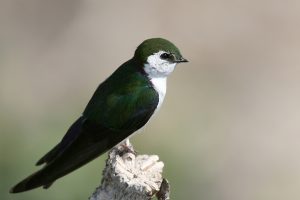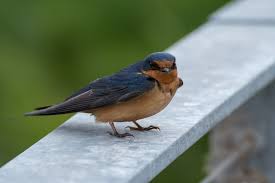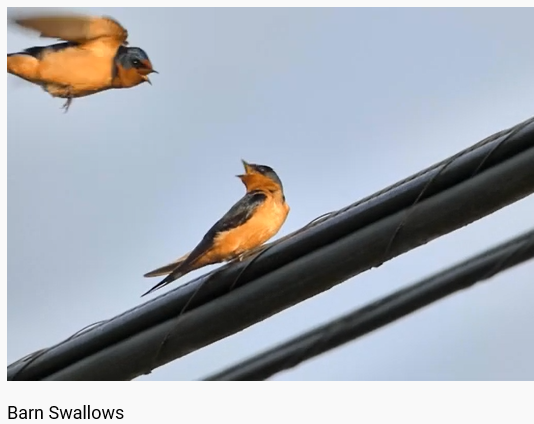EDITOR’S NOTE: Have you noticed the birds? Virginia Prowell, the Pioneer’s 95-years young poet, just gifted us with a “A Day in May” which mentions the very birds that our newest Pioneer columnist and birding enthusiast James Billstine provides insight into those graceful swallows. Welcome, James and enjoy this introduction to bird watching. If there are particular birds that you would like more information about, please email editor@tillamookcountypioneer.net.
By James Billstine
As we move beyond a month of quarantine, many residents of Tillamook County have watched spring unfold from behind a window. Whether that window is the window of a car or home, the days continue to lengthen and get warmer and the appeal to outdoors continues to increase.
Many of our county and state parks are closed; but even with the closures there is good news- if you are patient, you can still see some of the most beautiful heralds of spring from your house or front yard.
Tillamook county is blessed in that through the years over 300 species of birds have been noted. While many of these have only been found once or twice in our century, some of the most vibrant species arrive on cue every spring. These gems of the sky are called Swallows.
From the family Hirundinidae, there are 75 species of Swallow in the world, 8 of which occur in North America. And of those 8 species, 6 breed in Tillamook County, and at least one of these part-time Tillamook County residents can be found flying around your home on early spring and summer mornings.
Two of the more common swallows in Tillamook County are the Violet-green Swallow and the Barn Swallow. As with many bird species, the common names contain clues or references to an aspect of the bird that can often be hard to see. But with the Violet-green Swallow, when perched in the right light, the brilliant green backs and violet-green wings and tail of the bird do the name justice.

Violet-green Swallows, as with all species of swallows, spend most of their day in flight. While it is possible to identify them in flight from their white “saddlebags” and wings-longer-than-tails silhouette, it is easier and in some ways more pleasing to admire them when perched.
Violet-green Swallows often use man-made nest boxes (link to species-specific birdhouse dimensions provided at the bottom), and can be seen perched on top of their adopted homes resting, preening, and guarding their territory from predators. But if there seem to be no nests immediately next to your home, you can still catch them resting on wires near your house. The key to this, along with patience, is to watch the weather. Misty mornings, rainy days, marine layer, and cold fronts push Violet-green swallows down from higher skies where they often feed; and the wetter and stronger the weather, the more likely a group of Violet-green swallows is to be found perched on telephone wires and fences.
A few mornings back an overcast sky did just that, and I found several of my neighborhood’s Violet-green Swallows, which fly past my house daily, perched on the cable and electrical wires around my front porch.
The key identifying characteristics of this bird are listed on the Cornell University “All About Birds” website:
“(Violet-green Swallows are) Small sleek bird with long pointed wings and slightly forked tails. Their long wings extend slightly beyond their tail when perched. In good light, adult males have a greenish-bronze back and iridescent violet rump. Note white cheek.”
Females can be slightly less vibrant, but still lean towards a greener back than other swallow species, and have a duller cap. Immature birds of all bird species can be difficult to identify, but the white “saddlebags” of the juvenile Violet-green Swallow are still a giveaway to its identification.
Another common Swallow that nests in Tillamook County is the Barn Swallow. These are the swallows that are found nesting on convenient building ledges and fixtures. While they can be messy, Barn Swallows do keep the insect population in check by consuming 850 insects every day. When Barn Swallow nests are discovered, many individuals and organizations put nest platforms on less-used parts of their buildings. Barn swallows will quickly move their mud-bowl nests to the less-frequented platform that is offered, and continue to keep the insect population down and raise their families in peace. (Link to Barn Swallow nest plans at end of article).

Barn Swallows are often seen flying just above ground level, and can also be seen perched at the edge of puddles collecting mud for their nests. Their orange throat and face, and deep blue back can all be helpful identifying characteristics, but for much of the spring Barn Swallows can be identified in flight by their long, forked tail. The “fork” in the description is a slight misnomer if you equate it with a dinner fork. The sweeping curve at the base of the tail draws stronger parallels with a rounded pitchfork, or a musical tuning fork.
So this spring, as the sun climbs higher and the days become warmer, keep your eyes peeled for these summer residents raising their families near your home.
Link to Violet-Green Swallow Nest Box Plans
https://nestwatch.org/learn/all-about-birdhouses/birds/violet-green-swallow/
Link to Barn Swallow Nest Box Plans
https://nestwatch.org/learn/all-about-birdhouses/birds/barn-swallow/
Link to Cornell Lab of Ornithology’s Allaboutbirds Identification Help Page
https://www.allaboutbirds.org/guide/


.png)